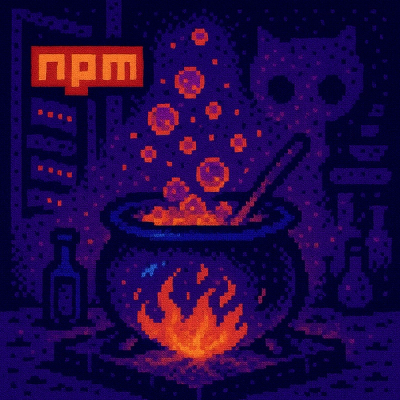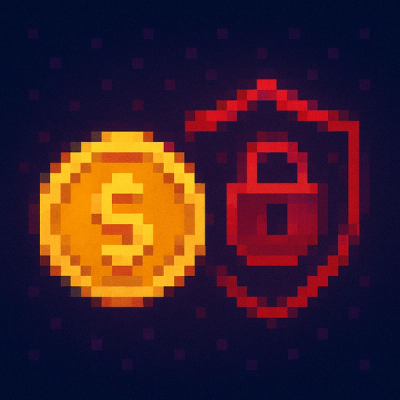
Security News
The Changelog Podcast: Practical Steps to Stay Safe on npm
Learn the essential steps every developer should take to stay secure on npm and reduce exposure to supply chain attacks.
@react-three/gltfjsx
Advanced tools
https://user-images.githubusercontent.com/2223602/126318148-99da7ed6-a578-48dd-bdd2-21056dbad003.mp4
A small command-line tool that turns GLTF assets into declarative and re-usable react-three-fiber JSX components.
Gltfjsx creates a virtual, nested graph of all the objects and materials inside your asset. It will not touch or modify your files in any way. Now you can easily make the data dynamic, alter contents, add events, or re-use the asset.
Usage
$ npx gltfjsx [Model.js] [options]
Options
--types, -t Add Typescript definitions
--verbose, -v Verbose output w/ names and empty groups
--meta, -m Include metadata (as userData)
--shadows, s Let meshes cast and receive shadows
--printwidth, w Prettier printWidth (default: 120)
--precision, -p Number of fractional digits (default: 2)
--draco, -d Draco binary path
--root, -r Sets directory from which .gltf file is served
--transform, -T Transform the asset for the web (draco, prune, resize)
--debug, -D Debug output
First you run your model through gltfjsx. npx allows you to use npm packages without installing them.
npx gltfjsx model.gltf
It creates a javascript file that plots out all of the assets contents. The original gltf must still be be in your /public folder of course.
/*
auto-generated by: https://github.com/pmdrs/gltfjsx
author: abcdef (https://sketchfab.com/abcdef)
license: CC-BY-4.0 (http://creativecommons.org/licenses/by/4.0/)
source: https://sketchfab.com/models/...
title: Model
*/
import { useGLTF, PerspectiveCamera } from '@react-three/drei'
export default function Model(props) {
const { nodes, materials } = useGLTF('/model.gltf')
return (
<group {...props} dispose={null}>
<group name="camera" position={[10, 0, 50]} rotation={[Math.PI / 2, 0, 0]}>
<PerspectiveCamera fov={40} near={10} far={1000} />
</group>
<group name="sun" position={[100, 50, 100]} rotation={[-Math.PI / 2, 0, 0]}>
<pointLight intensity={10} />
</group>
<mesh geometry={nodes.robot.geometry} material={materials.metal} />
<mesh geometry={nodes.rocket.geometry} material={materials.wood} />
</group>
)
}
useGLTF.preload('/model.gltf')
This component can now be dropped into your scene. It is asynchronous and therefore must be wrapped into <Suspense> which gives you full control over intermediary loading-fallbacks and error handling.
import { Canvas } from '@react-three/fiber'
import { Suspense } from 'react'
import Model from './Model'
function App() {
return (
<Canvas>
<Suspense fallback={null}>
<Model />
</Suspense>
Now you could re-use it:
<Model position={[0, 0, 0]} />
<Model position={[10, 0, -10]} />
Or make the model dynamic. Change its colors for example:
<mesh geometry={nodes.robot.geometry} material={materials.metal} material-color="green" />
Or exchange materials:
<mesh geometry={nodes.robot.geometry}>
<meshStandardMaterial color="hotpink" />
</mesh>
Make contents conditional:
{condition && <mesh geometry={nodes.robot.geometry} material={materials.metal} />}
Add events:
<mesh geometry={nodes.robot.geometry} material={materials.metal} onClick={handleClick} />
You don't need to do anything if your models are draco compressed, since useGLTF defaults to a draco CDN. By adding the --draco flag you can refer to local binaries which must reside in your /public folder.
If your GLTF contains animations it will add drei's useAnimations hook, which extracts all clips and prepares them as actions:
const { nodes, materials, animations } = useGLTF('/model.gltf')
const { actions } = useAnimations(animations, group)
If you want to play an animation you can do so at any time:
<mesh onClick={(e) => actions.jump.play()} />
If you want to blend animations:
const [name, setName] = useState("jump")
...
useEffect(() => {
actions[name].reset().fadeIn(0.5).play()
return () => actions[name].fadeOut(0.5)
}, [name])
The asset will be preloaded by default, this makes it quicker to load and reduces time-to-paint. Remove the preloader if you don't need it.
useGLTF.preload('/model.gltf')
Add the --types flag and your GLTF will be typesafe.
type GLTFResult = GLTF & {
nodes: { robot: THREE.Mesh; rocket: THREE.Mesh }
materials: { metal: THREE.MeshStandardMaterial; wood: THREE.MeshStandardMaterial }
}
export default function Model(props: JSX.IntrinsicElements['group']) {
const { nodes, materials } = useGLTF<GLTFResult>('/model.gltf')
With the --transform flag it creates a binary-packed, draco-compressed, texture-resized (1024x1024), deduped and pruned GLTF ready to be consumed on a web site. It uses glTF-Transform. It will not alter the original but create a copy and append [modelname]-transformed.glb.
import { parse } from '@react-three/gltfjsx'
import { GLTFLoader, DRACOLoader } from 'three-stdlib'
const gltfLoader = new GLTFLoader()
const dracoloader = new DRACOLoader()
dracoloader.setDecoderPath('https://www.gstatic.com/draco/v1/decoders/')
gltfLoader.setDRACOLoader(dracoloader)
gltfLoader.load(url, (gltf) => {
const jsx = parse(filename, gltf, config)
})
The GLTFStructureLoader can come in handy while testing gltf assets. It allows you to extract the structure without the actual binaries and textures making it possible to run in a testing environment.
import { GLTFStructureLoader } from '@react-three/gltfjsx'
import fs from 'fs/promises'
it('should have a scene with a blue mesh', async () => {
const data = await fs.readFile('./model.glb')
const { scene } = await new Promise(res => loader.parse(data, '', res))
expect(() => scene.children.length).toEqual(1)
expect(() => scene.children[0].type).toEqual("mesh")
expect(() => scene.children[0].material.color).toEqual("blue")
})
/public folderFAQs
GLTF to JSX converter
The npm package @react-three/gltfjsx receives a total of 433 weekly downloads. As such, @react-three/gltfjsx popularity was classified as not popular.
We found that @react-three/gltfjsx demonstrated a not healthy version release cadence and project activity because the last version was released a year ago. It has 2 open source maintainers collaborating on the project.
Did you know?

Socket for GitHub automatically highlights issues in each pull request and monitors the health of all your open source dependencies. Discover the contents of your packages and block harmful activity before you install or update your dependencies.

Security News
Learn the essential steps every developer should take to stay secure on npm and reduce exposure to supply chain attacks.

Security News
Experts push back on new claims about AI-driven ransomware, warning that hype and sponsored research are distorting how the threat is understood.

Security News
Ruby's creator Matz assumes control of RubyGems and Bundler repositories while former maintainers agree to step back and transfer all rights to end the dispute.